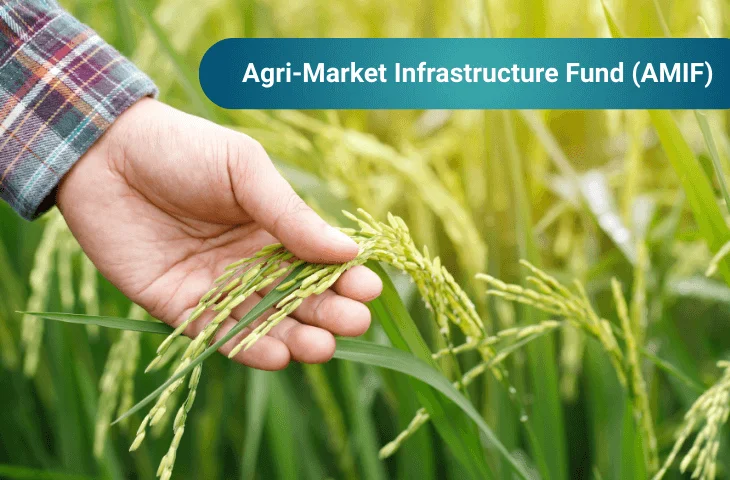The Agri Market Infrastructure Fund (AMIF) is a government scheme launched by the Cabinet Committee on Economic Affairs (CCEA) in 2019, aimed at developing and upgrading agricultural marketing infrastructure across India.
What is the Agri Market Infrastructure Fund (AMIF)?
The Agri Market Infrastructure Fund was created with NABARD (National Bank for Agriculture and Rural Development) with an initial corpus of Rs. 2,000 crore. Its primary goal is to improve infrastructure in Gramin Agricultural Markets (GrAMs) and Agricultural Produce Market Committees (APMCs), ensuring better market access for farmers and reducing post-harvest losses.
The AMIF targets both physical infrastructure development and technological integration, including e-NAM (National Agriculture Market) linkage for transparent online trading.
Why was the AMIF Scheme Created?
Agriculture is the backbone of India, employing over 50% of the population. However, more than 86% of Indian farmers are small and marginal, often unable to access wholesale markets or sell directly to consumers. The lack of proper market infrastructure leads to distress sales and reduced income for farmers.
The Agri Market Infrastructure Fund was created to:
- Upgrade rural markets into Gramin Agricultural Markets (GrAMs).
- Improve storage, grading, and quality certification facilities.
- Reduce intermediaries in the agricultural supply chain.
- Enable farmers to access competitive prices through direct marketing or online platforms like e-NAM.
- Promote scientific storage and value addition at the farm gate.
Who Administers the AMIF?
The scheme is administered by the Ministry of Agriculture and Farmers Welfare (MoA&FW), Government of India. NABARD acts as the financial intermediary, providing subsidized loans to State and Union Territory governments for implementing approved projects.
What are the Key Features of the AMIF?
The AMIF comes with several key features:
- Funding: Rs. 2,000 crore initial corpus created by NABARD through market borrowings.
- Beneficiaries: State and UT governments, who can access subsidized loans for market development projects.
- Eligible Projects: Development of GrAMs and APMCs, scientific storage, grading, quality certification, IT integration, and value addition.
- Implementation Models: Projects can be implemented in public-private partnership (PPP) mode or under Hub and Spoke models.
- Integration with e-NAM: Linking GrAMs and APMCs to the National Agriculture Market portal for online trade.
Check Out: Complete List of Important Schemes for NABARD Grade A Exam
How does AMIF Work?
The implementation of AMIF involves several stages:
| Step | Details |
| State Proposals | States submit proposals for market infrastructure projects to the Ministry of Agriculture, Cooperation & Farmers Welfare. |
| Approval and Loan | Upon recommendation, states can avail subsidized loans from NABARD under the AMIF. |
| Project Implementation | Funds are used for infrastructure development like storage, grading, marketing facilities, and IT integration to improve efficiency. |
What is the Purpose of the AMIF?
The primary purpose of the Agri Market Infrastructure Fund is to enhance farmers’ income by providing better access to markets and improving market infrastructure. The objectives include:
- Developing Gramin Agricultural Markets (GrAMs) and upgrading APMCs.
- Reducing post-harvest losses through modern storage facilities.
- Promoting value addition at the farmer level.
- Enabling online trade through e-NAM for price transparency.
- Providing direct marketing platforms for farmers and consumers.
What is the Significance of AMIF?
The significance of the scheme lies in its focus on small and marginal farmers, who often lack resources to store or transport their produce to wholesale markets. The benefits include:
- Enhanced Holding Capacity: Rural godowns allow farmers to store produce and avoid distress sales.
- Market Access: Improved infrastructure enables farmers to sell at remunerative prices.
- Reduction in Intermediaries: Direct marketing reduces reliance on middlemen, increasing farmers’ share of revenue.
- Value Addition: Processing and grading improve the marketability of produce.
- Integration with e-NAM: Facilitates transparent online trading and better price discovery.
The scheme also aligns with historical initiatives like the Grameen Bhandaran Yojana (2001) and Agricultural Marketing Infrastructure (AMI) under ISAM.
Get ready to crack government job exams with leading educators
How is AMIF Linked with Gramin Agricultural Markets (GrAMs) and APMCs?
The scheme aims to develop 22,000 GrAMs and upgrade 585 APMCs across the country. Earlier, rural haats were developed through MGNREGA under the Ministry of Rural Development, but now AMIF facilitates their upgradation using specialized market development funds.
GrAMs act as local platforms for farmers to sell directly to consumers or bulk buyers. APMCs provide regulated market spaces ensuring fair trade practices and price transparency. Linking these markets to e-NAM strengthens online trading, enabling farmers to access wider markets.
What are the Eligible Projects Under AMIF?
AMIF supports projects that strengthen agricultural marketing infrastructure. Some eligible projects include:
- Storage Infrastructure: Construction of warehouses, godowns, and cold storages (50–5000 MT for private/cooperatives, 50–10,000 MT for state agencies).
- Market Development: Upgradation of rural haats into GrAMs.
- Processing Units: Establishment of small-scale processing and value addition units.
- Quality Certification: Grading, cleaning, and standardization of agricultural produce.
- IT Integration: Linking markets to e-NAM and implementing electronic display systems for price information.
- Logistics & Ancillary Infrastructure: Transportation facilities like reefer vans, Integrated Value Chain (IVC) projects, and farmer-consumer direct marketing systems.
Who can Apply for Assistance Under AMIF?
Assistance under AMIF is available to a wide range of beneficiaries, including:
- Individuals and agri-preneurs.
- Farmers and Farmer Producer Organizations (FPOs).
- Cooperatives and Cooperative Marketing Federations.
- State agencies, NGOs, and SHGs.
- Local bodies and panchayats.
- Firms, companies, and autonomous government bodies.
How does AMIF Provide Financial Support?
The fund provides subsidized loans to State and UT governments. The interest subsidy is provided by NABARD, as per the annual budget allocations for 2018-19 and 2019-20, and is valid until 2024-25.
The scheme operates as a demand-driven model, meaning states can submit proposals based on their requirements for rural market development. Implementation is monitored closely to ensure that the benefits reach small and marginal farmers effectively.
Also Check: List of Government Schemes of India
What is the Role of NABARD in AMIF?
NABARD, the National Bank for Agriculture and Rural Development, is responsible for:
- Creating the AMIF corpus through market borrowings.
- Providing subsidized loans to states and UTs.
- Monitoring the implementation of projects.
- Ensuring financial discipline and timely utilization of funds.
- Coordinating with FPOs, cooperatives, and other stakeholders to facilitate project execution.
What are the Benefits of AMIF to Farmers?
The AMIF scheme provides multiple benefits:
- Better Market Access: Farmers can sell produce in upgraded GrAMs and APMCs.
- Remunerative Prices: Reduction in intermediaries ensures higher profit margins.
- Reduced Post-Harvest Losses: Scientific storage and cold storage facilities help preserve produce.
- Value Addition: Processing units enhance the quality and marketability of products.
- Farmer-Consumer Linkages: Direct marketing strengthens the farmer-consumer interface.
- Integration with e-NAM: Farmers can access transparent online trading platforms.
- Competitive Marketing Channels: Multiple channels enable farmers to choose the best options for their produce.
What is the Implementation Period of AMIF?
The implementation period for the Agri Market Infrastructure Fund is 2018-19 to 2025-26, which includes a moratorium period of two years. During this period, states and UTs can submit proposals, avail loans, and implement market infrastructure projects.
How is AMIF Related to Agricultural Marketing Infrastructure (AMI)?
AMIF is closely linked to the Agricultural Marketing Infrastructure (AMI) sub-scheme, which is part of the Integrated Scheme for Agricultural Marketing (ISAM).
AMI focuses on:
- Creating scientific storage facilities.
- Developing marketing and processing infrastructure.
- Integrating rural haats with GrAMs.
- Supporting post-harvest operations and cold chains.
Beneficiaries under AMI include individuals, FPOs, cooperatives, and state agencies, who can access back-ended subsidies ranging from 25% in plain areas to 33.33% in North-Eastern, hilly, and SC/ST-promoted projects.
Key Takeaways
| Aspect | Details |
| Administered By | Ministry of Agriculture & Farmers Welfare (MoA&FW) |
| Funding Agency | NABARD |
| Initial Corpus | Rs. 2,000 crore |
| Beneficiaries | State/UT Governments, FPOs, Cooperatives, Individuals |
| Eligible Projects | GrAMs, APMCs, Storage, Processing, IT integration |
| Implementation Models | Public-Private Partnership (PPP), Hub & Spoke |
| Integration | e-NAM portal for online trade |
| Period | 2018-19 to 2025-26 (2-year moratorium) |
| Objective | Improve market access, reduce post-harvest losses, enhance farmer income |
| Significance | Benefits small and marginal farmers; promotes direct marketing |
Also Read:
Questions for Government Exam Aspirants Based on Agri Market Infrastructure Fund
Q1. When was the Agri Market Infrastructure Fund approved?
a) 2018
b) 2019
c) 2020
d) 2017
e) 2016
Q2. What is the total corpus of AMIF?
a) Rs. 1,000 crore
b) Rs. 2,000 crore
c) Rs. 5,000 crore
d) Rs. 500 crore
e) Rs. 3,000 crore
Q3. Which body manages the financial aspect of AMIF?
a) RBI
b) NABARD
c) SIDBI
d) SEBI
e) Ministry of Finance
Q4. How many Gramin Agricultural Markets (GrAMs) are targeted under AMIF?
a) 10,000
b) 22,000
c) 15,000
d) 5,000
e) 25,000
Q5. Which portal is integrated with AMIF for online trading?
a) GeM
b) e-NAM
c) UPI
d) SWAYAM
e) PM-Kisan
Q6. What is the main objective of AMIF?
a) Agricultural insurance
b) Crop loan distribution
c) Market infrastructure development
d) Fertilizer subsidy
e) Land reform
Q7. Which ministry administers the AMIF scheme?
a) Ministry of Rural Development
b) Ministry of Finance
c) Ministry of Agriculture & Farmers Welfare
d) Ministry of Commerce
e) Ministry of Micro, Small & Medium Enterprises
Q8. How long is the implementation period of AMIF?
a) 2018-2023
b) 2018-2026
c) 2019-2024
d) 2020-2025
e) 2017-2022
Q9. Which type of projects are eligible under AMIF?
a) Storage and cold storage
b) Grading and quality certification
c) IT infrastructure for e-NAM
d) Hub & Spoke PPP projects
e) All of the above
Q10. What is the significance of AMIF for small farmers?
a) Reduces credit access
b) Promotes distress sales
c) Increases holding capacity and market access
d) Reduces government intervention
e) Encourages monocropping
Answer Key
| Question No. | Correct Answer |
| Q1 | b) 2019 |
| Q2 | b) Rs. 2,000 crore |
| Q3 | b) NABARD |
| Q4 | b) 22,000 |
| Q5 | b) e-NAM |
| Q6 | c) Market infrastructure development |
| Q7 | c) Ministry of Agriculture & Farmers Welfare |
| Q8 | b) 2018–2026 |
| Q9 | e) All of the above |
| Q10 | c) Increases holding capacity and market access |
Frequently Asked Questions
Ans: Ministry of Agriculture & Farmers Welfare (MoA&FW), Government of India.
Ans: NABARD.
Ans: 22,000 GrAMs and 585 APMCs.
Ans: Enables storage, reduces distress sales, promotes direct marketing, and improves income.
Ans: Until the financial year 2024-25.
- MISHTI Scheme, India’s Initiative to Restore Mangrove Ecosystems
- National Green Hydrogen Mission Features, Objectives, and Benefits
- Paramparagat Krishi Vikas Yojana, Transforming India’s Organic Farming
- Mission on Integrated Development of Horticulture NHM and HMNEH
- Swachh Bharat Mission, India’s Journey Towards Cleanliness and Hygiene
- SAGY, A Step Towards Holistic Development of Indian Villages

Priti Palit, is an accomplished edtech writer with 4+ years of experience in Regulatory Exams and other multiple government exams. With a passion for education and a keen eye for detail, she has contributed significantly to the field of online learning. Priti’s expertise and dedication continue to empower aspiring individuals in their pursuit of success in government examinations.
